Book contents
- Frontmatter
- Contents
- Preface
- Flexible Weinstein manifolds
- The Hirzebruch–Riemann–Roch Theorem in true genus-0 quantum K-theory
- On some deformations of Fukaya categories
- Morphisms of CohFT algebras and quantization of the Kirwan map
- Deformation of expressions for elements of an algebra
- Microlocal theory of sheaves in symplectic topology
- Algebra + homotopy = operad
Flexible Weinstein manifolds
Published online by Cambridge University Press: 25 June 2025
- Frontmatter
- Contents
- Preface
- Flexible Weinstein manifolds
- The Hirzebruch–Riemann–Roch Theorem in true genus-0 quantum K-theory
- On some deformations of Fukaya categories
- Morphisms of CohFT algebras and quantization of the Kirwan map
- Deformation of expressions for elements of an algebra
- Microlocal theory of sheaves in symplectic topology
- Algebra + homotopy = operad
Summary
This survey on flexible Weinstein manifolds, which is essentially an extract from [Cieliebak and Eliashberg 2012], provides to an interested reader a shortcut to theorems on deformations of flexible Weinstein structures and their applications.
1. Introduction
The notion of a Weinstein manifold was introduced in [Eliashberg and Gromov 1991], formalizing the symplectic handlebody construction from AlanWeinstein's paper [1991] and the Stein handlebody construction from [Eliashberg 1990]. Since then, the notion of a Weinstein manifold has become one of the central notions in symplectic and contact topology. The existence question for Weinstein structures on manifolds of dimension > 4 was settled in [Eliashberg 1990]. The past five years have brought two major breakthroughs on the uniqueness question: From [McLean 2009] and other work we know that, on any manifold of dimension > 4 which admits a Weinstein structure, there exist infinitely many Weinstein structures that are pairwise nonhomotopic (but formally homotopic). On the other hand, Murphy's h-principle for loose Legendrian knots [Murphy 2012] has led to the notion of flexible Weinstein structures, which are unique up to homotopy in their formal class. In this survey, which is essentially an extract from [Cieliebak and Eliashberg 2012], we discuss this uniqueness result and some of its applications.
1A. Weinstein manifolds and cobordisms.
Definition. A Weinstein structure on an open manifold V is a triple (ω, X, ∅ )Where
•(ω is a symplectic form on V ,
•∅:V→ℝ is an exhausting generalized Morse function,
Information
- Type
- Chapter
- Information
- Symplectic, Poisson, and Noncommutative Geometry , pp. 1 - 42Publisher: Cambridge University PressPrint publication year: 2014
